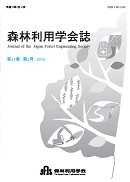Volume 27, Issue 1
Displaying 1-13 of 13 articles from this issue
- |<
- <
- 1
- >
- >|
Foreword of special issue
-
Article type: Article
2012Volume 27Issue 1 Pages 3-5
Published: January 31, 2012
Released on J-STAGE: April 03, 2017
Download PDF (518K)
Article
-
Article type: Article
2012Volume 27Issue 1 Pages 7-16
Published: January 31, 2012
Released on J-STAGE: April 03, 2017
Download PDF (1558K) -
Article type: Article
2012Volume 27Issue 1 Pages 17-23
Published: January 31, 2012
Released on J-STAGE: April 03, 2017
Download PDF (1168K)
Research and technical report
-
Article type: Article
2012Volume 27Issue 1 Pages 25-29
Published: January 31, 2012
Released on J-STAGE: April 03, 2017
Download PDF (1136K)
Research and technical note
-
Article type: Article
2012Volume 27Issue 1 Pages 31-37
Published: January 31, 2012
Released on J-STAGE: April 03, 2017
Download PDF (2576K) -
Article type: Article
2012Volume 27Issue 1 Pages 39-42
Published: January 31, 2012
Released on J-STAGE: April 03, 2017
Download PDF (1030K) -
Article type: Article
2012Volume 27Issue 1 Pages 43-49
Published: January 31, 2012
Released on J-STAGE: April 03, 2017
Download PDF (2658K) -
Article type: Article
2012Volume 27Issue 1 Pages 51-58
Published: January 31, 2012
Released on J-STAGE: April 03, 2017
Download PDF (3215K) -
Article type: Article
2012Volume 27Issue 1 Pages 59-61
Published: January 31, 2012
Released on J-STAGE: April 03, 2017
Download PDF (1504K) -
Article type: Article
2012Volume 27Issue 1 Pages 63-66
Published: January 31, 2012
Released on J-STAGE: April 03, 2017
Download PDF (650K) -
Article type: Article
2012Volume 27Issue 1 Pages 67-68
Published: January 31, 2012
Released on J-STAGE: April 03, 2017
Download PDF (237K)
Review
-
Article type: Article
2012Volume 27Issue 1 Pages 69-80
Published: January 31, 2012
Released on J-STAGE: April 03, 2017
Download PDF (2221K)
Research and technical report
-
Article type: Article
2012Volume 27Issue 1 Pages 81-86
Published: January 31, 2012
Released on J-STAGE: April 03, 2017
Download PDF (831K)
- |<
- <
- 1
- >
- >|
